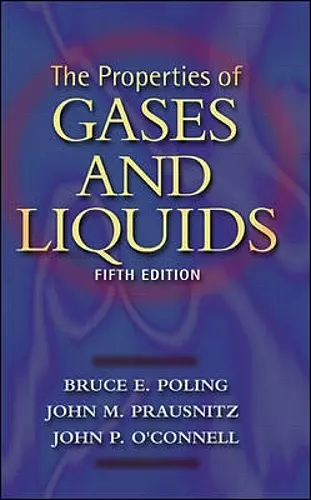The Properties of Gases and Liquids 5E
Bruce Poling author John O'Connell author John Prausnitz author
Format:Hardback
Publisher:McGraw-Hill Education - Europe
Currently unavailable, and unfortunately no date known when it will be back

Publisher's Note: Products purchased from Third Party sellers are not guaranteed by the publisher for quality, authenticity, or access to any online entitlements included with the product.
Updating their hefty reference approximately every decade since 1958, chemical engineers Poling (U. of Toledo), John M. Prausnitz (U. of California-Berkeley), and John P. O'Connell (U. of Virginia) describe and critically review various estimation procedures for a limited number of properties of gases and liquids. Among those properties are critical and other pure component properties; pressure-volume- temperature relationships and thermodynamic properties of pure components and mixtures; vapor pressures and phase-change enthalpies; standard enthalpies of formation; standard Gibbs energy of formation; heat capacity; surface tension; viscosity; thermal conductivity; diffusion coefficients; and phase equilibria. They compare most of the estimated properties to experimental findings to indicate reliability, and illustrate most methods with examples.
Ever since the first edition of this work was published in 1958, it has been a "must have" in the reference library of Chemical Engineers, particularly those engaged in process design. It has long been the primary reference for anyone who must estimate physical or thermodynamic properties required for equipment design knowing little more than the chemical formula of the materials to be handled. The main value of this book over a simple bibliography that can now be generated by a computer search is that the authors continue the practice started in the first edition of publishing tables comparing the results of using the various estimation methods to each other and experimental data when available and then make recommendations as to which method seems to work best under various conditions. The need for regular updating was succintly stated by Reid and Sherwood in their Preface to the second edition in 1966 when they commented that the half life of estimation correlations seemed to be about four years. Although there are now more fundamentally based properties estimation methods than there were then, the authors note in their Preface to the new edition that "...most estimation methods rely heavily on empiricism..." Thus the need for periodic updating of this work continues. Space does not permit listing chapter by chapter the significant differences from the previous edition, but they are substantial. The properties data bank in Appendix A has been completed revised. This new edition should be added to the library of anyone who must estimate physical properties of materials to be processed. -- Kunesh, John AIChE Journal 20011201 By L. A. Wenzel, Lehigh University This new edition provides a very thorough and careful presentation of modern methods of estimating the physical properties of gases and liquids. Pure gases, pure liquids, multicomponent mixtures of gases and of liquids, and equilibrium multiphase systems are all considered. In the phase equilibria area, solid-liquid and solid-gas systems are included. Properties considered include vapor pressure, critical properties, boiling and freezing points, PVT (pressure-volume-temperature) properties, thermodynamic properties (viscosity, thermal conductivity, diffusion coefficents, and surface tension). Estimation methods are chosen for their accuracy, range of utility, and the availability of needed input data. Methods that are based on a theoretical model of the system are generally preferred. The emphasis on new work is strong, so that in many cases, old familiar methods are omitted. A very extensive database of properties of pure components is provided in the appendixes. Generally, simplicity has been sacrificed to accuracy, so that these methods will not be as easy for the process engineer to use, as was the case with earlier editions. Still, this is a useful, and possibly even vital book for a practicing process engineer; highly recommended for libraries serving them. Graduate students through professionals. Choice 20010501
ISBN: 9780070116825
Dimensions: 231mm x 155mm x 59mm
Weight: 1452g
768 pages
5th edition